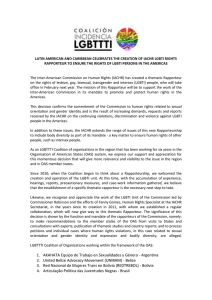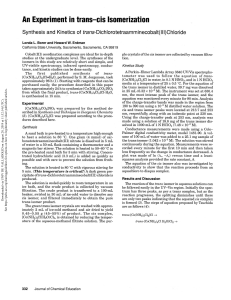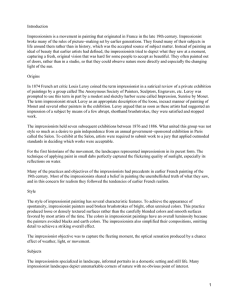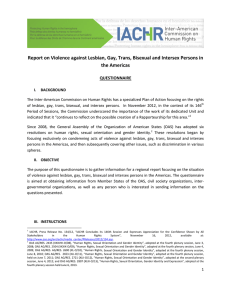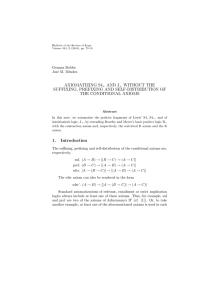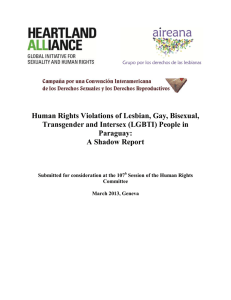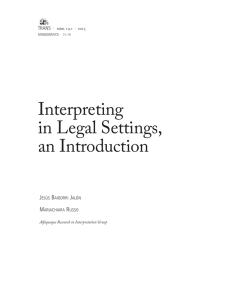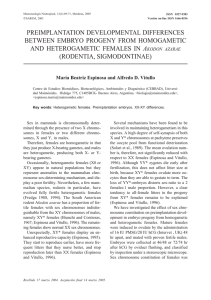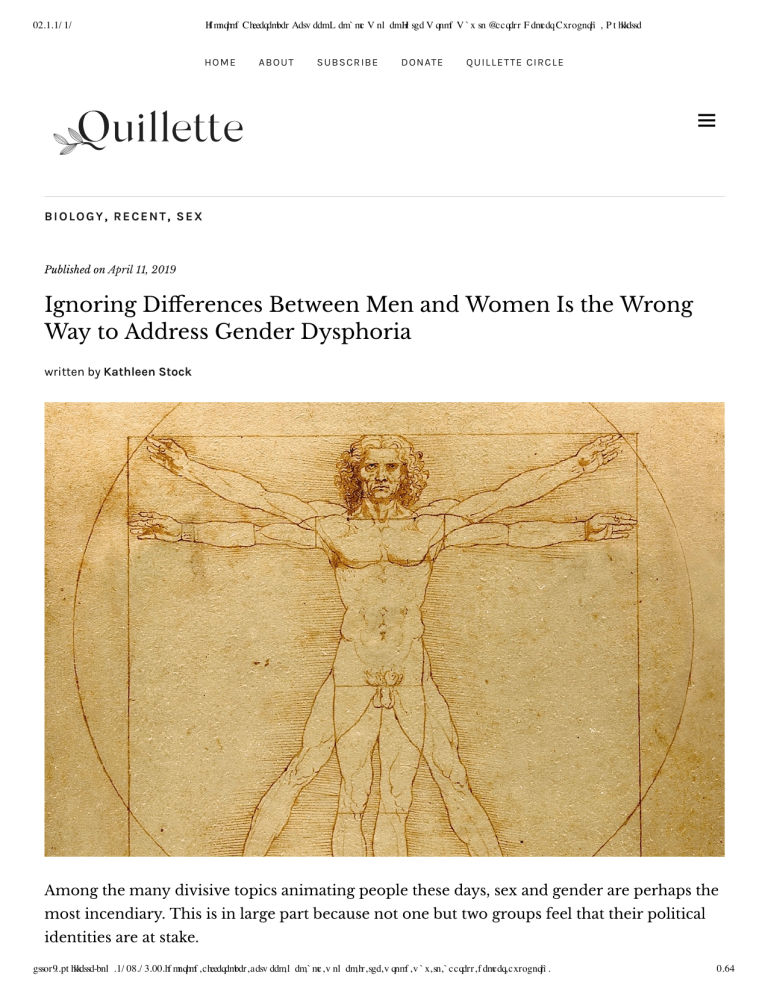
02.1.1/ 1/ Hf mnqhmf Cheedqdmbdr Adsv ddmL dm` mc V nl dmHr sgd V qnmf V ` x sn @ccqdrr F dmcdq Cxrognqh` , P t hkkdssd HOME ABOUT SUBSCRIBE DONATE QUILLETTE CIRCLE BIOLOGY, RECENT, SEX Published on April 11, 2019 Ignoring Di erences Between Men and Women Is the Wrong Way to Address Gender Dysphoria written by Kathleen Stock Among the many divisive topics animating people these days, sex and gender are perhaps the most incendiary. This is in large part because not one but two groups feel that their political identities are at stake. gssor9..pt hkkdssd-bnl .1/ 08./ 3.00.hf mnqhmf ,cheedqdmbdr,adsv ddm,l dm,` mc,v nl dm,hr,sgd,v qnmf ,v ` x,sn,` ccqdrr,f dmcdq,cxrognqh` . 0.64 02.1.1/ 1/ Hf mnqhmf Cheedqdmbdr Adsv ddmL dm` mc V nl dmHr sgd V qnmf V ` x sn @ccqdrr F dmcdq Cxrognqh` , P t hkkdssd On one hand, many women feel blindsided by the argument that trans women should be considered literal women, and question the e ect of the trans movement on female sex-based rights and protections, as they have come to de ne them. On the other, many trans people are aghast at what they feel are attempts to block their political advancement toward equal social and legal status. Whether the arenas of dispute are bathrooms, schools, sport, women’s organizations, or parades, the emotions are intense and the arguments apparently intractable. To understand what’s at stake, it’s helpful to delineate two argumentative positions at play: (1) sex eliminationism, which argues for the abolition of the recognition of biological sex as a meaningful category; and (2) gender eliminationism, which argues for the abolition of gender. As a feminist and philosopher who nds herself stuck between these two positions and their passionate advocates, I see it as a de ning challenge of our complicated modern times to carve out some pragmatic middle ground: to nd a narrative and set of policies protective of both the rights of trans people in a gender-conforming society, and those of females in a misogynist society. In attempting this, we should recognize that many on both sides of the dispute share at least some common ground. Speci cally, they both share a deep discomfort with the sociocultural norms and stereotypes associated with being a woman or a man. I believe that this common ground may provide some basis for rapprochement. Since a lot of skirmishes in the gender wars involve people talking past each other, we rst need to pause to clarify certain terminology. We should remember that “sex” here primarily refers to a biological category and has nothing to do with sexuality (or not directly, anyway). We also need to note that “gender” has several common meanings. O en, “gender” is used, perfectly correctly, as an ordinary synonym for “sex.” Equally, the terms “woman” and “man” have traditionally been treated as straightforward synonyms for “female” and “male,” and all four terms have referred to sex category. But in the 1970s, as Pepperdine University philosopher Tomas Bogardus recently noted in Quillette, “gender” also came to refer to the social and cultural norms and stereotypes governing a particular sex category, in relation to behavior, role, mental characteristics and appearance. There is also a third use of “gender,” which is particularly prevalent in academic circles, though not more widely. This is the idea, perceptively explored by Bogardus, that “gender” should stand not only for the sociocultural norms associated with biological sex, but also that we should de ne the terms “woman” and “man” in terms of the sociocultural roles associated with those norms. This is a step that goes well beyond previously staked claims, which le our sex-based de nitions of the terms “woman” and “man” as they were. In contrast, this move, as Bogardus makes clear, de nes the very notions of womanhood and manhood, not in terms of the biological, but the sociocultural. gssor9..pt hkkdssd-bnl .1/ 08./ 3.00.hf mnqhmf ,cheedqdmbdr,adsv ddm,l dm,` mc,v nl dm,hr,sgd,v qnmf ,v ` x,sn,` ccqdrr,f dmcdq,cxrognqh` . 1.64 02.1.1/ 1/ Hf mnqhmf Cheedqdmbdr Adsv ddmL dm` mc V nl dmHr sgd V qnmf V ` x sn @ccqdrr F dmcdq Cxrognqh` , P t hkkdssd Some feminist philosophers use “gender,” “woman” and “man” in this way. A particular ri on this move, grounded in the prior work of Andrea Dworkin and Catharine MacKinnon, is the argument that we should take a pattern of speci cally oppressive sociocultural relations, associated with femaleness and maleness respectively, as de nitive of what counts as womanhood and manhood. It seems to follow that, to be truly progressive, we should aim to eliminate womanhood and manhood altogether as meaningful categories. Later on, I shall have mostly negative things to say about such “social-role” views of gender, as Bogardus calls them—but not yet. In the meantime, I’ll use “sex” to refer to biological sex, and “gender” only to refer to the sociocultural norms and stereotypes governing biological sex. Since I disagree with the idea that the terms “woman” and “man” either do, or should, refer only to distinctive sociocultural roles, I will continue to use these two terms with their original, still-perfectly-respectable meanings, as denoting females and males, in the biological sense, respectively. *** A somewhat odd aspect of this dispute is that both sides nominally tend to have at least one core belief in common. This is the thought that gender, in the sense of sociocultural norms, can be a source of harm. It harms women, who are endlessly confronted with objectifying images purporting to represent them. It harms men who feel like failures for being unable to provide for their families. It harms children who nd themselves read against type, teased as “scaredy-cat” boys or “bossy” girls. It makes older women seem less authoritative and older men more so. It teaches girls to be sexually submissive, and boys to be sexually aggressive, against the better interests of both. It’s a likely contributory factor to the prevalence of selfharm and anorexia in females, and of depression and suicide in males. At every turn, by way of external or internal pressures, gender can limit one’s life—including in ways that go unnoticed. No doubt, many readers disagree with a lot of this. They might argue that what I am treating here as sociocultural norms are in fact biologically produced di erences. They might say that at least some gender norms conform to expectations that arise from the di erent forms of genetically encoded, evolutionarily developed programming contained in men and women. In either case, there’s less likely to be talk about harm. Even so, it’s possible to coherently combine a view that some behavioral and mental characteristics are endogenously sexed and unalterable, with the view that many others are functions of environment and culture. So any di erences on this score should not prevent us gssor9..pt hkkdssd-bnl .1/ 08./ 3.00.hf mnqhmf ,cheedqdmbdr,adsv ddm,l dm,` mc,v nl dm,hr,sgd,v qnmf ,v ` x,sn,` ccqdrr,f dmcdq,cxrognqh` . 2.64 02.1.1/ 1/ Hf mnqhmf Cheedqdmbdr Adsv ddmL dm` mc V nl dmHr sgd V qnmf V ` x sn @ccqdrr F dmcdq Cxrognqh` , P t hkkdssd from joining to lament the harms caused by at least some sociocultural norms in regard to maleness and femaleness. One group that apparently is particularly harmed by gender comprises those whose alienation from prescribed norms contributes to their feeling radically at odds with their bodies. The words we use for this distress is “gender dysphoria”: strong discomfort at the sexed aspects of physiognomy, even to the point of feeling “born into the wrong body.” It seems likely that gender-dysphoric people have been around for as long as gendered societies have existed. Indeed, it’s tempting to speculate about a causal link between the two. In social worlds with rigid physical and mental stereotypes governing males and females, it is predictable that some people, having unconsciously internalized those stereotypes as the “right” way for males and females to be, will then look at their particular, non-stereotypical bodies or minds, and self-diagnose as internally discordant, with radicalized feelings to match. Feelings of wrongness can, in certain cases, tip over into a dualist narrative of an outside that doesn’t fully t one’s insides. Though it’s hard to pin down the reasons, the expression of gender dysphoria is on the increase. The UK Gender Identity Service, a National Health Service provider, has in the last few years seen a big rise in referrals among children, from ninety-seven in 2009–2010 to 2,519 in 2017–2018. One, though not the only, recognized therapeutic response to feelings of gender dysphoria is social transition: living as a di erent sex. Most trans women, trans men and so-called non-binary people have, in response to feelings of dysphoria, made the decision to live as the opposite sex, or in the case of some non-binary people, as no sex at all. Some of these people go on to procure a legal sex change. Yet neither social nor legal transition can change facts about individual sex determination and di erentiation at a biological level. No surgery or hormone treatment can achieve this, either. Nevertheless, by social (or sometimes socio-legal) means—such as by adopting gendered behaviors, clothing and sometimes surgically-constructed or drug-altered appearances, culturally indicative of a particular sex (or, in the case of nonbinary people, indicative of androgyny)—these individuals can attempt to reduce the distressing mismatch they feel between how they wish to be perceived and how they are perceived, both by themselves and others. Transition may be e ective for many. And it is commonly claimed that it reduces overall suicide risk in dysphoric individuals. But it can also have severe personal costs. Where stark di erences are promoted between the sexes, those perceived to sit uncomfortably between gendered worlds are vulnerable to projected ridicule, harassment or even disgust. All trans people recognized as such—whether through self-declaration or because they don’t “pass”— are vulnerable in this regard. Arguably, then, gender can doubly harm trans people: by helping to induce their dysphoria in the rst place, then punishing them for their survival strategy. gssor9..pt hkkdssd-bnl .1/ 08./ 3.00.hf mnqhmf ,cheedqdmbdr,adsv ddm,l dm,` mc,v nl dm,hr,sgd,v qnmf ,v ` x,sn,` ccqdrr,f dmcdq,cxrognqh` . 3.64 02.1.1/ 1/ Hf mnqhmf Cheedqdmbdr Adsv ddmL dm` mc V nl dmHr sgd V qnmf V ` x sn @ccqdrr F dmcdq Cxrognqh` , P t hkkdssd What kind of society, then, should we attempt to build, to help gender-dysphoric people? In contemporary public discussion and practice, two competing approaches can be discerned, each with di erent social consequences. (In what follows, I deliberately articulate extreme versions of both; in reality, of course, many on each side endorse only certain aspects and reject others, but it remains true that a signi cant number of people would, in each case, endorse the extreme version). The rst approach—what I’m calling sex eliminationism—says we should remove any social practice whatsoever that would serve to di erentiate trans people from those who are born into (or, if you prefer, “assigned at birth” into) their preferred (i.e., self-identi ed) sex category. The ideal, under this strategy, would be the seamless integration of trans women into all female social and legal categories, and trans men into corresponding male categories, without any unsought reference to either’s sex category. An underlying assumption of sex eliminationism is that if we built a society that didn’t recognize biological sex, the social problems faced by trans people would be minimized. The second approach—which I call gender eliminationism—argues that we should instead get rid of gender, as that word is understood to encompass sociocultural norms and stereotypes. The ideal, under this strategy, is a world of males and females, recognized biologically as such, but with none of the prevalent stereotypes associated with those categories. This strategy, as it intersects with the issue of gender dysphoria, seeks to counter the narrative that there is a particular right or “normal” way for males and females to be, in the hope that those su ering from dysphoria will no longer feel so ill-at-ease. Though activist groups do not, to my knowledge, use the term “sex eliminationism,” this has in e ect become the preferred approach of all mainstream LGBT charities and lobbying groups in western countries. Within a limited but in uential sphere, the strategy has had considerable political success. Under Barack Obama in 2016, reference to “sex” as a characteristic protected under Title IX of the Education Amendments Act of 1972 was o cially interpreted as a reference to “gender identity.” When the UK Equalities Minister Penny Mordaunt told reporters in 2018 that “trans women are women,” she was echoing the stance of the British LGBT charity Stonewall: Trans women, such groups tell us, are women in every literal sense, and anyone who disagrees should “get over it.” Many public organizations in the UK have followed states such as California by making the sex one “identi es as having”—not the sex one has by birth, or even at law—the determinant of whether they may permissibly enter women-only spaces, with or without a legal sex change. This policy is known internationally as “self-ID.” From prisons to youth hostels to colleges to changing rooms to swimming pools to shared train sleeper carriages to hospital wards, self-ID has become the de facto criterion of entry. gssor9..pt hkkdssd-bnl .1/ 08./ 3.00.hf mnqhmf ,cheedqdmbdr,adsv ddm,l dm,` mc,v nl dm,hr,sgd,v qnmf ,v ` x,sn,` ccqdrr,f dmcdq,cxrognqh` . 4.64 02.1.1/ 1/ Hf mnqhmf Cheedqdmbdr Adsv ddmL dm` mc V nl dmHr sgd V qnmf V ` x sn @ccqdrr F dmcdq Cxrognqh` , P t hkkdssd The UK government recently has come under signi cant pressure to use self-ID as the sole criterion required for a legal sex change—without any con rmation of surgery, medical diagnosis of dysphoria, or other substantive constraints. A vast and fractious public government consultation took place about this last year, the results of which have yet to be published. Countries that already have made self-ID a largely su cient basis for sex changeeligibility include Canada, Ireland, Denmark, Norway and Sweden, as have New York State, California and Nevada. According to many sex eliminationists, we should make a universal practice of referring to “gender identity” instead of sex, and encode this practice in law and policy. And gender identity, in turn, means the sex with which one feels strongly aligned. To buttress the claim that sex is not a useful category, sex eliminationists tend to emphasize the existence of di erences in sexual development (“DSDs”), which characterize the relatively small group of people sometimes also known as “intersex.” The appearance of DSDs is consistent with the view of many philosophers, including me, that there is no hard and fast “essence” to biological sex, at least in our everyday sense: no set of characteristics a male or female must have, to count as such. But competent non-essentialists don’t think it follows from this that there are no real constraints on what counts as sex (or biological kinds, for that matter). Rather, as the philosopher Alison Stone has argued, the concept of biological sex is what philosophers call a “cluster concept.” That is, it’s determined by possession of most or all of a cluster of particular designated properties—chromosomal, gametic, hormonal and morphological—produced via endogenous biological processes. The vast majority of us have all of the designated properties for a given sex; a smaller number have most; a tiny number— much smaller than typically reported—have some of both. Perhaps this entails that sex is not a binary, or that there are more than two sexes—or perhaps not. Either way, there’s no good reason to think we can coherently go from facts about proliferating material sex categories to a conclusion about the nonexistence of material sex. A further source of support for sex eliminationism comes from post-structuralist philosophy. Biological sex, we are told by enthusiastic readers of Judith Butler, is socially constructed. This isn’t just the claim that sex has social meaning, or that sex isn’t a binary. It’s the much more radical claim that sex is socially produced all the way down: There are no material, non-social facts underpinning our habitual division into male and female. It’s easy to see how this otherwise startling claim ts nicely into a sex-eliminationist case—for if there’s no such thing as material facts about sex, then all that we’re le with is gender identity. This is not a widely endorsed view—in part because, as I have just noted, there is an entirely respectable (and far less radical) alternative to this conclusion, which is that sex categories are e ectively clusters of (non-social) material properties. And even if this were wrong, and it were true that sex is thoroughly socially constructed, this wouldn’t support the idea that the gssor9..pt hkkdssd-bnl .1/ 08./ 3.00.hf mnqhmf ,cheedqdmbdr,adsv ddm,l dm,` mc,v nl dm,hr,sgd,v qnmf ,v ` x,sn,` ccqdrr,f dmcdq,cxrognqh` . 5.64 02.1.1/ 1/ Hf mnqhmf Cheedqdmbdr Adsv ddmL dm` mc V nl dmHr sgd V qnmf V ` x sn @ccqdrr F dmcdq Cxrognqh` , P t hkkdssd collective social fact of sex should be ignored, politically, in favor of a subjective inner feeling of gender identity. A social fact is no less a fact for being social in character. A nal source of argumentative support for sex eliminationism is allegedly embedded in the social-role view of womanhood and manhood, as described by Bogardus, and sketched out in my introduction above. This says that—whether or not material facts about femaleness and maleness exist or not—the terms “woman” and “man” don’t actually refer to those facts, but rather refer to sociocultural roles. One of the main draws of this sort of view has been its apparently “inclusive” nature: If womanhood is no longer shackled to femaleness, transwomen can be women too, at least in this sense. As Bogardus writes: “Adopting this view of sex and gender allowed the acceptance of transgender people as individuals who genuinely are the gender they take themselves to be—with, one hopes, a consequent reduction in oppression, bullying and medical pathologizing.” There are, however, several problems with the social-role view. I agree with Bogardus that, as a supposed reconstruction of our existing public concepts of woman and man, the social-role view is alien to the ordinary, non-academic manner by which people discuss and classify human beings. Some philosophers acknowledge this, explicitly arguing instead for a revisionary or “ameliorative “ approach. They argue that “woman” and “man” ideally should refer to two social roles, as an improvement on ordinary usage, even if the ordinary terms don’t do so now. But advocates of this proposal fail to properly consider the likely negative e ects of any such revision that would appear alongside any expected bene ts. For many women, to have such a fundamental category as womanhood so closely tied, via de nition, to a socially disadvantaged position, is o ensively reductive, not to mention demoralizing. (This is especially so in relation to the version of a social-role view that explicitly identi es womanhood in terms of oppression and objecti cation.) This isn’t, of course, to deny that oppressive social roles exist for women; it’s to argue that womanhood shouldn’t be de ned in those terms. Moreover, social-role views arguably are just as divisive as they are inclusive, since they apparently suggest that females who don’t occupy whatever social role is supposed to be normative for womanhood aren’t real women. Social-role views also fail on the narrow goal of being “inclusive” to trans people. If we are to take the concept of social role seriously, we must acknowledge that it entails complex processes of formation, starting in childhood development, and manifesting in many di erent facets of behavior, self-conception and one’s treatment by others. They certainly cannot be easily shi ed or cast o by a relatively “surface” change such as changing one’s appearance or getting drugs or surgery. Many trans men retain their pre-transition social role, postgssor9..pt hkkdssd-bnl .1/ 08./ 3.00.hf mnqhmf ,cheedqdmbdr,adsv ddm,l dm,` mc,v nl dm,hr,sgd,v qnmf ,v ` x,sn,` ccqdrr,f dmcdq,cxrognqh` . 6.64 02.1.1/ 1/ Hf mnqhmf Cheedqdmbdr Adsv ddmL dm` mc V nl dmHr sgd V qnmf V ` x sn @ccqdrr F dmcdq Cxrognqh` , P t hkkdssd transition; as do many trans women. This is o en noted wryly by old-school feminists, but is equally noted by trans activists, unhappy at the still-cha ng restrictions this apparently puts upon who may count as a woman or man, and who may not. For this reason, as Bogardus relates, some philosophers in tune with the zeitgeist recently have rejected social-role views of womanhood, and moved to accounts more rmly rooted in a subjective feeling of gender identity. As Bogardus describes, one variant of the latter makes womanhood a matter of self-identi cation directly; another makes womanhood a matter of feeling that the norms of womanhood apply to oneself. I share Bogardus’s reservations about both of these variants. But either way, the argument here is that feelings maketh the woman; and, as with the social-role view, biological sex is rmly out of the picture as irrelevant. The main public, non-academic driver of sex eliminationism isn’t biology or philosophy. It’s a political project rooted in the commendably empathic desire to make things right for vulnerable people in psychological distress; to shield them from harassment; and to provide them with an environment in which gender dysphoria is minimized. Yet a growing number of voices are pointing out that sex eliminationism is detrimental to the interests of another group, also with historical claims to vulnerability. *** The main problem with sex eliminationism is that, in a nutshell, it leaves us with no adequate language to describe a politically important feature of material reality. For a range of purposes, academics and statisticians need to track actual facts about sex, as it operates across various social groups, practices and discourses. The elimination of talk of sex hampers that. To take a concrete example: current proposals to base data about the numbers of males and females in the Scottish 2021 Census directly on the basis of the individual self-identi cation of respondents, and even to introduce a third “non-binary” option, risk corrupting what is normally a major source of research data for academics and policy-makers about sex and related matters. Categorizing sex is particularly important if you want to describe the e ects of sexism and misogyny. Most participants in this dispute recognize, at least on paper, that sexism and misogyny exist. A major source of opposition to sex eliminationism has come from secondwave-inspired feminists, concerned about inequality predicated on sex-category membership. These feminists—of which I am one—assume that, alongside inequality based on race, class and other markers, there is a distinctive form of inequality directed at females as such, by virtue of their belonging to the category of people associated with the burden of reproduction, as well as, on average, their being the physically weaker sex. These two facts, so gssor9..pt hkkdssd-bnl .1/ 08./ 3.00.hf mnqhmf ,cheedqdmbdr,adsv ddm,l dm,` mc,v nl dm,hr,sgd,v qnmf ,v ` x,sn,` ccqdrr,f dmcdq,cxrognqh` . 7.64 02.1.1/ 1/ Hf mnqhmf Cheedqdmbdr Adsv ddmL dm` mc V nl dmHr sgd V qnmf V ` x sn @ccqdrr F dmcdq Cxrognqh` , P t hkkdssd the story goes (a story I happen to believe), have led to the historical exploitation and oppression of females. Indeed, many harmful gender stereotypes are thought to stem indirectly from these facts. We can see the negative e ects on sex eliminationism upon data about sex, and so upon data about harm to females in a misogynist society, if we look at new practices regarding the statistical tracking of crime. Guidance o ered by the UK Crown Prosecution Service, and apparently currently followed by UK police and the court system, advises that “all relevant papers regarding prosecutions involving victims…or defendants make reference to the correct presented gender status.” Lobbying organizations such as GLAAD advise the U.S. media to report crimes by trans people in a manner consonant with the criminals’ and victims’ preferred self-identi cation. This practice thwarts the reasonable aim of getting a clear statistical picture of certain types of crime according to sex category, both in terms of perpetrators and victims. In a society where sexual assaults on females by males is apparently endemic, this aim is especially pressing. Removing references to sex, and replacing them with self-ID, also means undermining the capacity to combat sexism, since the practice undermines special measures originally introduced to create equality of opportunity in a sexist world. To take just one example, the UK Labour Party’s decision in 2018 to admit trans women as eligible for the role of Constituency Party Women’s O cer —a role naturally understood as designed to facilitate equality of opportunity for females in a male-dominated organization—has resulted in at least two cases of trans women successfully obtaining the role in their respective constituencies. There are also issues for females in relation to a policy of self-ID in certain public spaces. Sexseparated spaces are an imperfect but useful form of protection for females in places where they are vulnerable to sexual aggression and invasions of privacy, such as bathrooms, changing rooms, dormitories, refuges and prisons. Recent Freedom of Information requests reveal that in the UK, two-thirds of sexual assaults in public pools and leisure centers took place in mixed-sex or “unisex” facilities. A pre-operative trans woman prisoner, Karen White, sexually assaulted two female inmates recently whilst on remand in a British women’s prison. Critics argue from such evidence that making self-ID the legitimate means of accessing women-only spaces puts females in those spaces at risk—occasionally from trans women, but also from predatory males who are not trans, but who now cannot be con dently challenged in such spaces. The inclusive language of “gender-neutrality” tends to obscure the fact that a policy of self-ID e ectively makes spaces mixed-sex by stealth. gssor9..pt hkkdssd-bnl .1/ 08./ 3.00.hf mnqhmf ,cheedqdmbdr,adsv ddm,l dm,` mc,v nl dm,hr,sgd,v qnmf ,v ` x,sn,` ccqdrr,f dmcdq,cxrognqh` . 8.64 02.1.1/ 1/ Hf mnqhmf Cheedqdmbdr Adsv ddmL dm` mc V nl dmHr sgd V qnmf V ` x sn @ccqdrr F dmcdq Cxrognqh` , P t hkkdssd Though defenders of self-ID eagerly point to studies apparently dismissing such worries as unfounded, plenty of time is needed to see the real impact. And those with expertise in safeguarding would prefer a cautious attitude in the meantime. We also shouldn’t forget that, alarmingly, it’s unclear how authorities would even know about the extent of any problems, given the approach to crime recording just described. In considering this di cult issue, we need to be aware of the fact, o en glossed over or treated as heresy if mentioned, that a substantial number of trans women are pre-operative and retain natal genitalia, and that many are sexually attracted to females. The public stereotype of a trans woman as a post-operative transsexual, attracted only to males, has yet to catch up with the reality of the so-called “trans umbrella.” With respect to the point about female-attraction, critics tend to cry: “But what about lesbians in woman-only spaces”? But crucially, there’s no analogous pattern of lesbian aggression here that is even remotely equivalent to background facts regarding statistical male violence patterns, generally; not to mention the average strength di erentials between biological men and biological women. (Even if there were, there would be no practically available conventional means of keeping lesbians out of female-only spaces, as we already have, more or less, for males in the case of single-sex provision.) Another important though neglected aspect of sex eliminationism is its far-reaching implications for how we categorize, and then politically protect, sexual orientation, including lesbianism. Orientation categories—heterosexuality, homosexuality and bisexuality—are normally de ned in terms of: (1) the sex of the subject; and (2) the sex (or sexes) to which the subject is attracted. In the new sex-eliminationist paradigm, however, each orientation is now supposed to be de ned in terms of: (1) the gender identity of the subject; and (2) the gender identity (or identities) to which the subject is attracted. Hence female-attracted trans women, and trans woman-attracted females, can be “lesbians.“ Male-attracted trans men, and trans man-attracted males, can be “gay men.” This apparently leaves us with no linguistic resources to talk about that form of sexual orientation that continues to arouse the distinctive kind of bigotry known as homophobia. This won’t cease to exist just because it’s no longer talked about. There’s also a signi cant worry about the e ect on vulnerable emerging sexualities of gay children and teens, when told by peers and lobbying organizations that trans people of the opposite sex are “lesbians” and “gay men” just like them. In most other settings, progressives would be quick to denounce the peer-pressuring of gay young people to renounce their fundamental orientation; in queer circles, matters now do not seem so clear-cut. gssor9..pt hkkdssd-bnl .1/ 08./ 3.00.hf mnqhmf ,cheedqdmbdr,adsv ddm,l dm,` mc,v nl dm,hr,sgd,v qnmf ,v ` x,sn,` ccqdrr,f dmcdq,cxrognqh` . 0/ .64 02.1.1/ 1/ Hf mnqhmf Cheedqdmbdr Adsv ddmL dm` mc V nl dmHr sgd V qnmf V ` x sn @ccqdrr F dmcdq Cxrognqh` , P t hkkdssd *** We now move to gender eliminationists, in whose idealized world there would be candid and unproblematic talk of sex, but there would be no gender—no behaviors stereotypically associated with being male or female at all. Gender eliminationists therefore reject the quasimystical notion of “gender identity.” They see it as contributing to the promulgation of gender hang-ups, assuming that gender identity is in fact determined by whichever gendered stereotypes one feels t one best. We are told of trans teenager Jazz Jennings that, “growing up, Jazz’s bedroom was lled with girly things—pink bed linen, a closet lled with dresses and an ample collection of stu ed animals.” We are told of British trans celebrity Munroe Bergdorf that “as a child, she would regularly steal her mum’s lip gloss and wear it to school.” There’s nothing remotely harmful about these activities for males, gender eliminationists argue. What is harmful, however, is society agreeing that such activities are a part of what it means to be a woman or girl. For gender eliminationists, then, a fundamental problem with sex eliminationism is its inherent conservativism. And indeed, some draw attention to the fact that many of the supposedly tell-tale signs of gender dysphoria among trans-identi ed children seem like stereotypes plucked out of ladies’ home-furnishing magazines from the early Cold War era. Sex eliminationism appears to calcify gender, imprisoning both trans and non-trans people alike in its restrictive grip. The application of the category “cis” is thought to contribute to this phenomenon. Sex eliminationists o en use the term “cis” to designate, within the otherwise supposedly uni ed classes of women and men, those members who don’t feel challenged by the gender norms applicable to them, and therefore are not trans. Yet this seems inadequately simplistic, since many people who aren’t trans still feel strong unease at the gendered constraints imposed upon them. Gender eliminationists prefer to focus on protecting existing sex-based protections and resources, while simultaneously inhibiting the further entrenchment of gender. They protest the strati cation of societies into pink and blue. They defend and celebrate gender nonconformity, whether in career or fashion choice: stay-at-home dads and men in dresses, female engineers and women in tuxes. And many of them refuse to use the preferred pronouns or category-nouns of trans people. Though this practice is widely criticized, most don’t do it to be insulting. Rather, they do so as an expression of their allegiance to a philosophical position: one in which shi ing one’s use of pronouns and other descriptors to t a person’s gender identity, rather than their sex, contributes inadvertently to the further conservation of harmful gender norms. gssor9..pt hkkdssd-bnl .1/ 08./ 3.00.hf mnqhmf ,cheedqdmbdr,adsv ddm,l dm,` mc,v nl dm,hr,sgd,v qnmf ,v ` x,sn,` ccqdrr,f dmcdq,cxrognqh` . 00.64 02.1.1/ 1/ Hf mnqhmf Cheedqdmbdr Adsv ddmL dm` mc V nl dmHr sgd V qnmf V ` x sn @ccqdrr F dmcdq Cxrognqh` , P t hkkdssd The pursuit of gender eliminationism comes at an obvious cost: namely, distress caused to trans people. If successful integration is a therapeutic goal for trans people, the insistent use of sex-based pronouns, and other constant reminders of the sex they wish to forget, may seriously undermine well-being. When trans people describe themselves as living in fear, it’s rarely hyperbole. These are facts to which some gender eliminationists seem either oblivious or indi erent—inexplicably, since the threat to trans people for their nonconformity is another terrible by-product of the rigidly gendered social environment that gender eliminationists decry. The point is most starkly made in relation to policy decisions about how best to accommodate trans women in public spaces where they, too, can be vulnerable. Hardliners insist that trans women should be in male bathrooms, male hostels, male dormitories and prisons; that what happens to them there is of no concern to females, since females won’t be the direct perpetrators of any subsequent harm. A di erent and more general critique of gender eliminationism is whether the strategic objective of eliminating gender makes coherent sense in the light of knowledge about cognition. Increasingly, cognitive scientists are emphasizing that our brains are essentially predictive: constantly modelling on the basis of past experience, and updating the model only when incoming data doesn’t match the prediction. From vision to emotion to action choices, the role of unconscious, re exive prediction is increasingly thought to be critical to cognitive processes. This potentially includes implicit stereotypes, such as gender stereotypes. Some cognitive scientists propose that brains use stereotypes unavoidably, as part of their ordinary working, as a kind of energy-saving fast heuristic. If this is correct, then it seems that we cannot eliminate gender completely—since there will always be some social stereotypes about the sexes that remain programmed in our minds, if only because they correspond to statistically recurrent empirical truths about biological men and women. Instead of being gender eliminationists, the most we can reasonably be, perhaps, is “gender critical”: consciously critical of the particularly damaging social stereotypes we collectively uphold, aiming to replace them over time with better and more socially useful ones. *** And so we are le with two factions, feeling united only by resentment. Members of each camp delight in taking the most radicalized possible example of the opposition as representative. Each thinks the other more powerful. Both are right, in a sense. Sex eliminationism as a strategy has had extraordinary success in a small but in uential circle, gssor9..pt hkkdssd-bnl .1/ 08./ 3.00.hf mnqhmf ,cheedqdmbdr,adsv ddm,l dm,` mc,v nl dm,hr,sgd,v qnmf ,v ` x,sn,` ccqdrr,f dmcdq,cxrognqh` . 01.64 02.1.1/ 1/ Hf mnqhmf Cheedqdmbdr Adsv ddmL dm` mc V nl dmHr sgd V qnmf V ` x sn @ccqdrr F dmcdq Cxrognqh` , P t hkkdssd though it remains mostly incomprehensible to the population as a whole. (Thus, those who insist on the point that trans women are biologically male are le in the surreal position of being accused of heresy in the faculty lounge and banality in the pub.) Many on both sides, meanwhile, feel scared. Females, especially survivors of sexual assault, are frightened of losing places they can go without aggressive biological males being present. Trans women feel frightened for roughly the same reason, and worry that they won’t feel welcome in any space. Both feel as though they are losing their political identity. Social media doesn’t help, siphoning users into paranoid, angry silos. Critics of sex eliminationism are reduced by their opponents to the status of “TERF,” a pejorative that stands for “trans exclusive radical feminist,” whose use is habitually accompanied by sneering and sometimes threats of violence. For their part, gender eliminationists are also capable of dehumanizing and insulting language: referring to trans women as “trannies,” “men in frocks,” and so on. The wider political climate also doesn’t help. One obvious obstacle to encouraging calm discussion is the aggressive manner in which U.S. President Donald Trump has sought to undermine trans people in a number of arenas, for reasons that have, apparently, little to do with progressive concerns about gender in the sociocultural sense. To return to my premise: It’s worth remembering that both sides of this dispute are strongly uncomfortable with aspects of gender, though each has a di erent strategic response to the discomfort. Sex eliminationists want to help individual people “identify out” of a particular set of gendered norms, by eliminating talk of sex; gender eliminationists want to get rid of the norms that cause discomfort in the rst place, for everyone. Pragmatists should try to draw upon this limited common ground, constructively. I confess that I skew to the gender-eliminationist side of the debate—or, at least, that I reject sex eliminationism as a workable or desirable strategy. And the proposal I o er below re ects this. But I also ask whether it is possible simultaneously to, on the one hand, act compassionately and respectfully toward trans people in a way that ts their desired selfimage, and doesn’t expose them to harm; while, on the other hand, avoid entrenching the gendered norms that harm people generally, especially females, and that may well partly cause dysphoria in the rst place. I think one important rst step is to talk about an aspect of the debate that most people— especially trans advocates—would prefer to ignore, because it feels impolite. But we cannot dance around the issue if we hope to make progress. gssor9..pt hkkdssd-bnl .1/ 08./ 3.00.hf mnqhmf ,cheedqdmbdr,adsv ddm,l dm,` mc,v nl dm,hr,sgd,v qnmf ,v ` x,sn,` ccqdrr,f dmcdq,cxrognqh` . 02.64 02.1.1/ 1/ Hf mnqhmf Cheedqdmbdr Adsv ddmL dm` mc V nl dmHr sgd V qnmf V ` x sn @ccqdrr F dmcdq Cxrognqh` , P t hkkdssd Legally, we are where we are: People have built the fabric of their lives around the possibility of legal transition, and that legal option shouldn’t be ripped away. However, in my view, we have to remain clear-eyed that legal transition is, and always was, ctional, not actual. The existence of a legal category of trans people implicitly asks people to inhabit a ction in which trans people are actually members of another sex, even if many don’t actually believe these equivalences to be real (the term I use later on is “ ctionalizing”). Indeed, one of the reasons the debate over this issue seems so raw and divisive is that even the most passionate trans advocates know, on some level, that they can’t get what they truly want (and never will)— which is the widespread and total acceptance, at the individual psychological level, of all trans women as full-on women and all trans-men as full-on men. There are limits to what policy and language can achieve. The human brain remains a reality-based organ. We’re generally very familiar with the social practice of acting: consciously inhabiting a role for a limited amount of time, and living “as if” something were true. When we watch a tragedy, we might laugh, cry, and cower in fear, but we don’t run onto the stage to save the protagonist. Away from the arts, knowingly engaging with and generating ctions are o en a crucial part of sensitive social interaction, and of sparing the feelings of others. Reality o en hurts, a er all. But equally, there are contexts where reference to reality is still needed. To help her recovery, I may act as if a loved one isn’t ill; but not when the doctor visits. My critics will no doubt leap to the point that trans women, in particular, have been presented throughout history as—in philosopher Talia Mae Bettcher’s words—“evil deceivers and make believers,” and that my position here taps into that trope, egregiously. But that would be to miss my point. “Make-believe” has connotations of playfulness and unseriousness that ctionalizing need not share. Fictionalizing, as I’ve just emphasized, can be a serious and socially valuable exercise: life-saving, even. Meanwhile, as I’ve also stressed, a practice of ctionalizing that is known to be such, exercised within circumscribed limits, and which is compatible with truth-telling in other contexts, is by de nition not deceitful, nor (obviously) is it evil. On one reading, current attempts to suppress talk of material facts about sex by progressive institutions and academics can be read as a sympathetic attempt to bolster the ction of actual transition: to preserve an illusion that sex-change is literally possible. In the background seems to be the assumption that to ctionalize about something successfully, you also need to ctionalize that you aren’t ctionalizing. But that would only be true if the goal of ctionalizing was getting people to actually and permanently believe something was real. In contrast, much social ctionalizing is non-deceptive: it doesn’t attempt to fully disguise its own nature. This is the kind of thing I’m suggesting we should aim for. gssor9..pt hkkdssd-bnl .1/ 08./ 3.00.hf mnqhmf ,cheedqdmbdr,adsv ddm,l dm,` mc,v nl dm,hr,sgd,v qnmf ,v ` x,sn,` ccqdrr,f dmcdq,cxrognqh` . 03.64 02.1.1/ 1/ Hf mnqhmf Cheedqdmbdr Adsv ddmL dm` mc V nl dmHr sgd V qnmf V ` x sn @ccqdrr F dmcdq Cxrognqh` , P t hkkdssd How should this all work in terms of policy? We should continue to grant those su ering from severe dysphoria the option of a legal sex-change in order to help them, assuming the evidence continues to show that it does indeed help. But equally, we must not detach that option from careful medical oversight and diagnosis, and proof of strong commitment from the applicants, for fear of the obvious dangers for females that such detachment would pose. Self-ID as a route to a legal sex change continues to be a terrible idea. Nor, more generally, should we lose track of the fact that sex isn’t literally changed. In some cases, it is good manners to pretend that a person really has changed their sex. But this act of politeness should not be encoded in law. As individuals and institutions, we should sympathetically encourage the voluntary use of preferred pronouns in interpersonal contexts for trans people, as a therapeutic device. But in the services of retaining a much-needed grip on reality, we must not enforce this practice, and nor should we banish reference to sex from those many discourses where we still absolutely need to discuss it. As a society, we should put resources into dedicated “third” spaces for trans people, wherever they risk harm: bathrooms, refuges, hostels, prisons. But sex-based legal protections, resources, and spaces should also be robustly maintained, wherever they are the best solution to sex-based harms. (Ironically, to date the public conversation has operated in strikingly binary fashion: either sex-based spaces and resources or trans-accommodating spaces and resources; yet we could have both). I realize that stating things so baldly will inevitably be shocking for those whose only goal seems to be to preserve illusions in this area, both for themselves and others. Sometimes you just have to step out of the ction for a while, and say how things really are. Too much is at stake not to. I also know that my proposal is unlikely to satisfy those at either pole of the dispute. Sex eliminationists will argue that trans people don’t want others to insultingly pretend. Gender eliminationists will object that ctions are inherently unstable things, constantly tempting us to take them more seriously than we should. The latter point doesn’t seem true; most of us can draw a clear line between ction and reality, as long as we know it’s ction we’re dealing with in the rst place. Meanwhile, to the former we should say: in a case of genuinely competing interests, as this undoubtedly is, it’s unreasonable to think that everyone will get exactly what they want. One might also ask the two sides what their objection is, precisely, to engaging with ctions: not least because each side seems to be doing a good deal of rather more deceptive ctionalizing already. E ectively, many sex eliminationists pretend that sex-based harm doesn’t exist; and many gender eliminationists pretend that trans-directed discrimination doesn’t exist. Yet the fact is that both do. We therefore need a sensible collective approach that gssor9..pt hkkdssd-bnl .1/ 08./ 3.00.hf mnqhmf ,cheedqdmbdr,adsv ddm,l dm,` mc,v nl dm,hr,sgd,v qnmf ,v ` x,sn,` ccqdrr,f dmcdq,cxrognqh` . 04.64 02.1.1/ 1/ Hf mnqhmf Cheedqdmbdr Adsv ddmL dm` mc V nl dmHr sgd V qnmf V ` x sn @ccqdrr F dmcdq Cxrognqh` , P t hkkdssd doesn’t leave us stuck, between a damaging tendency toward reality-denial on one side, and a brutal realism destructive of good social relations on the other. Kathleen Stock is a Professor of Philosophy at the University of Sussex. Follow her on Twitter at @Docstockk. Featured image: A section of Vitruvian Man, 1492, by Leonardo Da Vinci Share this: 392 WhatsApp Share Email Print Related How the Trans-Rights Movement Is Turning Philosophers Into Activists Gender’s Journey from Sex to Psychology: A Brief History I May Have Gender Dysphoria. But I Still Prefer to Base My Life on Biology, Not Fantasy F I L E D U N D E R : Biology, recent, Sex 198 Comments Morgan Foster April 11, 2019 @Kathleen Stock “I see it as a de ning challenge of our complicated modern times to carve out some pragmatic middle ground: to nd a narrative and set of policies protective of both the rights of trans people in a gender-conforming society, and those of females in a misogynist society. gssor9..pt hkkdssd-bnl .1/ 08./ 3.00.hf mnqhmf ,cheedqdmbdr,adsv ddm,l dm,` mc,v nl dm,hr,sgd,v qnmf ,v ` x,sn,` ccqdrr,f dmcdq,cxrognqh` . 05.64
